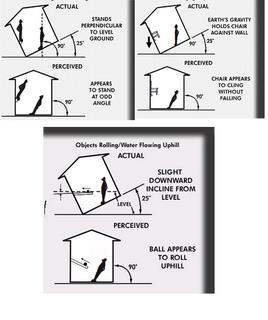
Mystery Spot - Illusion Science at UnitetoSolve
For the labor day weekend I happen to visit the world famous mystery spot at Santacruz, California. Having heard a little about the spot before, the word mystery created too much interest in me. The so called mystery spot is located on a dense forest area, surrounded by the redwood trees. The main attraction on the mystery spot is the tilted wooden house where in u can see people able to lean at an extreme angle without falling, defying the rules of gravity. Some other gimmicks shown there at the mystic spot include ball rolling uphill, leveled flat surfaces showing people taller than what they are, etc. will surely surprise everyone.
Surprised about the great ILLUSION effect created at the mystic spot, I did some research along with my research professor Dr.Google to know more about it. Here are some interesting things about how our eyes and brain see things.
Surprised about the great ILLUSION effect created at the mystic spot, I did some research along with my research professor Dr.Google to know more about it. Here are some interesting things about how our eyes and brain see things.
The anti-gravity house is actually built at an angle of 25° off the true horizontal. This will explain every effect seen. Once in the area of an anti-gravity house you are always comparing the effects to what you are used to -- normal-level floors and walls that are perpendicular to the ground.
The Leaning Off Walls Effect
On the left-top diagram you see the actual tilt of the house to the true horizontal.
Both people are perpendicular to the true horizontal. On the left-bottom, you see the situation as it is perceived by the people inside the room.
They have no access to the true horizontal, and are judging their surroundings by a horizontal that is created by the room. This causes one to have an internal change of reference frames, which causes the people to appear as they are actually leaning off the walls.
Clinging Objects Effect
The same reason as above accounts for this mysterious phenomena. In the middle-top diagram you can see that the Earth's gravity fully holds the chair against the wall. However, to the observer inside the room, the chair appears to mysteriously stay against the wall.
Objects Rolling/Water Flowing Uphill
On the right-top diagram, the board or trough is at a very slight downhill incline from the true horizontal (about 5 to 7 degrees). On the right-bottom, you can see how the effect appears to the observer. The house is tilted at an angle of 25 degrees. Someone inside the house perceives the upwards incline of the ramp to be 20 degrees, which is a pretty dramatic incline!
History of Anti-gravity Houses

The Leaning Off Walls Effect
On the left-top diagram you see the actual tilt of the house to the true horizontal.
Both people are perpendicular to the true horizontal. On the left-bottom, you see the situation as it is perceived by the people inside the room.
They have no access to the true horizontal, and are judging their surroundings by a horizontal that is created by the room. This causes one to have an internal change of reference frames, which causes the people to appear as they are actually leaning off the walls.
Clinging Objects Effect
The same reason as above accounts for this mysterious phenomena. In the middle-top diagram you can see that the Earth's gravity fully holds the chair against the wall. However, to the observer inside the room, the chair appears to mysteriously stay against the wall.
Objects Rolling/Water Flowing Uphill
On the right-top diagram, the board or trough is at a very slight downhill incline from the true horizontal (about 5 to 7 degrees). On the right-bottom, you can see how the effect appears to the observer. The house is tilted at an angle of 25 degrees. Someone inside the house perceives the upwards incline of the ramp to be 20 degrees, which is a pretty dramatic incline!
History of Anti-gravity Houses

Locations
There are quite a number of these anti-gravity places around the United States. They are well worth the visit! Here is a map.
Look in to this article from UC Berkeley http://www.berkeley.edu/news/berkeleyan/1998/0909/spot.html

1 comment:
Post a Comment